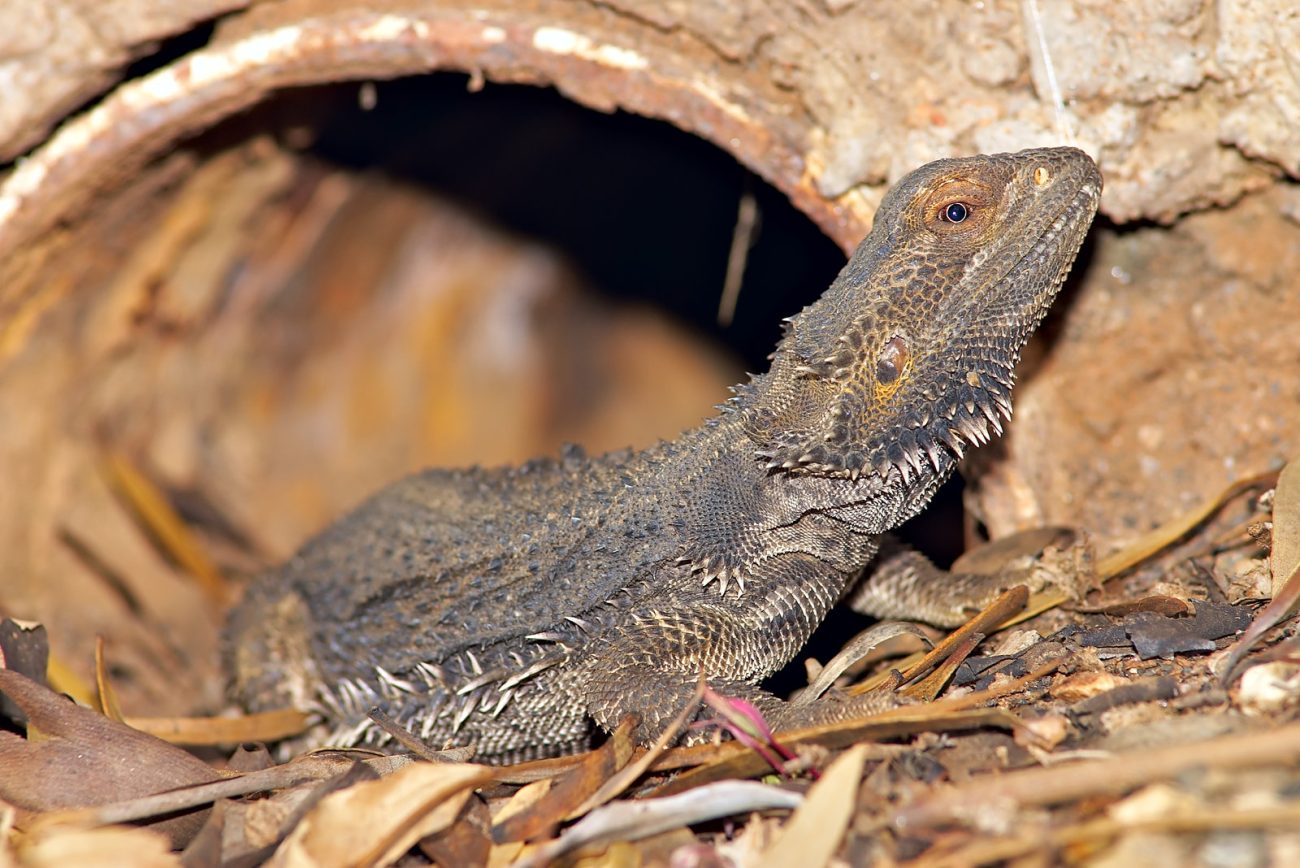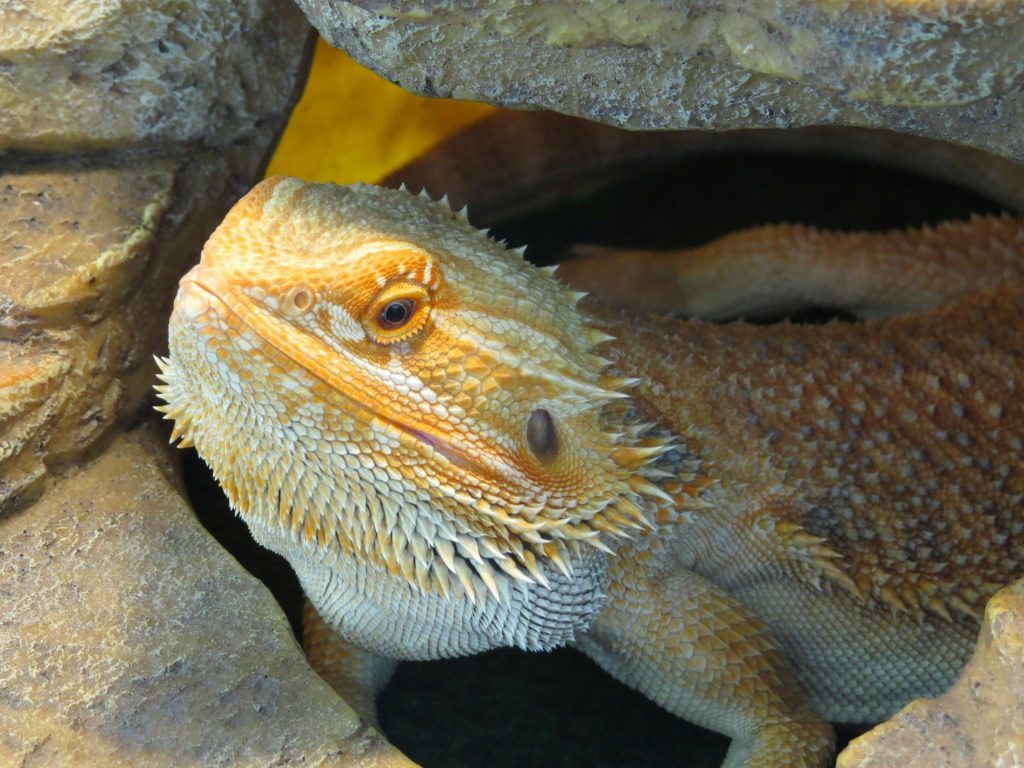Bearded dragons are active, diurnal lizards known for their shameless basking and displays. However, like any other creature, beardies also need a secluded, safe spot to rest or hide when threatened.
These spots are called reptile caves or hides.
The commercial reptile hide business is pretty developed, and many designs are available. However, the truth is that not too many caves are suitable for bearded dragons, especially when they reach their adult size.
Let’s overview the best bearded dragon-friendly caves and decorative materials that can be turned into a perfect hide.
1. Small World Slate and Stone Store’s Natural Slate Stones
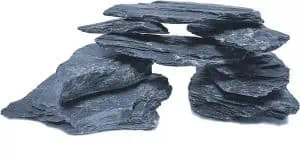
Pros
- Fully natural material
- Highly decorative due to its specific surface and dark color
- It lets you customize your leo enclosure and make it completely unique and naturalistic
- Slate provides a good grip for climbing, so your lizards can use the upper surface of the shelter as well.
- By buying these stones, you’re supporting a small, family-run US business.
Cons
- No premade hides – you’ll have to create them yourself from stones, which takes some time and effort.
If you have the option, a visit to your local home and garden supplier (hardware store, garden center, or other stone supplier) could be cheaper and more rewarding since you can pick adequate stones yourself.
🦎 Find the Small World Slate and Stone Store’s Natural Slate Stones on Amazon
2. Orchid Valley Reptile Hide, XL Large 14″ Hollow Log
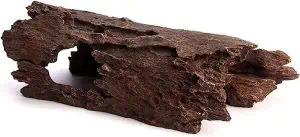
Pros
- A natural, cozy log shape
- The beardie can use the upper log surface for basking and hanging out
- Pretty natural look for an artificial log
Cons
- The medium log looks much more realistic, but it may be too small for fully-grown beardies; the larger one offers more space but is aesthetically more toy-like.
- Artificial material (plastic)
🦎 Find the Orchid Valley Reptile Hide on Amazon
3. Natural Large Coral Driftwood for Aquarium Decor, 10-15 Inch (2 pcs)
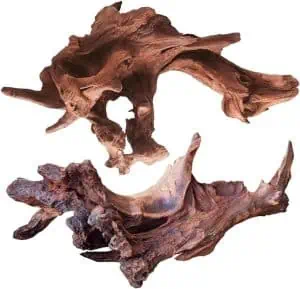
Pros
- Richness of shapes and sizes
- Natural material
- Highly decorative
- Allows you to get creative and combine the wood with other materials to create customized hides.
Cons
- It’s not a ready-made solution – you need to give some thought to the setup.
- You will more likely find it more useful as an additional hive than a primary beardie shelter.
🦎 Find the Hiwzitar Natural Large Coral Driftwood for Aquarium Decor on Amazon
4. Fluker’s Large Critter Cavern Reptile/Small Animal Hide
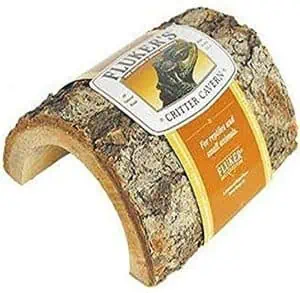
Pros
- The upper surface is smooth but still textured enough for your beardie to climb on
- You can use it in combination with other materials to make larger hides.
Cons
- Better suited for smaller beardies.
- The thickness of individual log items seems to vary. If you end up with one that is too thick, a larger beardie may be unable to squeeze in.
- You can easily find or carve a similar piece yourself – bake it to sterilize before use.
🦎 Find the Fluker’s Large Critter Cavern Reptile/Small Animal Hide on Amazon
5. Relaqcc Large Reptile Cave Climb Hideout
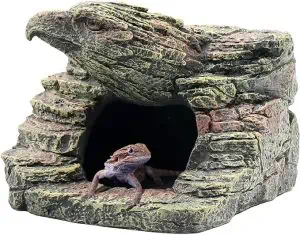
Pros
- The square shape of the cave’s base makes it good for fitting into a corner.
- The single entrance makes the cave extra-cozy and suitable for trying out a beardie humid hide if you like the idea.
Cons
- Despite the large cave, it may become too small for a full-size bearded dragon, especially since it has no alternative exit.
- The design might be a bit too tacky for some.
- Again, plastic (but it would be really tricky to carve that eagle into a real rock, true).
🦎 Find the Relaqcc Large Reptile Cave Climb Hideout on Amazon
6. Relaqcc Reptile Resting Terrace and Cave
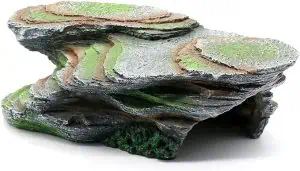
Pros
- Unlike with many other commercial hides, the entrance to this cave is spacious enough to fit in a beardie.
- A well-thought-out design.
Cons
- Although it tries to be realistic, the hide wouldn’t fit in too well visually in a naturalistic tank.
- Plastic material.
🦎 Find the Relaqcc Reptile Resting Terrace and Cave on Amazon
7. Excavator Clay
You may want to say that Excavator clay belongs in some substrate-related article, but think again. Excavator clay lets you make structures in the tank, including caves.
Also, it can help you fix other elements in place so you can combine materials with excavator clay to create bigger caves. Add sufficient water as instructed, and the substrate becomes a sticky clay mass that becomes hard after drying.
Pros
- Gives you a lot of freedom when designing an enclosure interior
- Helps you make bigger, customized caves
Cons
- Sometimes, it is challenging to work with.
- The dried clay might crack and crumble.
I would never advise using it to fix rocks or heavy material in place (however, you can cover the exterior of rock caves that you’ve safely glued).
FAQ
How Many Hides Should Bearded Dragons Have?
Bearded dragons should have a minimum of two hides – one on the cool side of the tank and one on the warm side. A third hide is a plus. It doesn’t have to be a real cave, but a decoration that is ‘hiding friendly’ and creates a secluded spot. You can create such hides using driftwood, slate, or tiles.
Why Does Your Bearded Dragon Need a Hide?
In nature, Bearded Dragons are commonly found in the open. They bask, males, display signaling to their rivals and potential mates, and can also respond to a threat with aggression. However, beardies are still prey animals – they’re targets of natural predators like birds, goannas, and snakes and introduced ones like dingoes, feral cats, and foxes.
Their instinct tells them always to be alert, ready to run for their lives and – hide. Each beardie basking or displaying proudly knows where it can run for cover on its territory.
Despite the lack of predators, this instinct doesn’t go away. Thus, not having a hide is mentally devastating for a bearded dragon and makes the stress levels skyrocket.
Bearded Dragons with no hides provided often try to squeeze themselves into corners and behind decorations. That is always such a sad sight to see because it signals a great deal of distress.
Bearded dragons also brumate during autumn and winter. They will take cover (yes, using a hide) and fall into a slumber for the entire cold season. Having a comfy cave during this period is important for them to relax and rest safely.
I know that some people are tempted to remove the bearded dragon. You can still find advice online that caves and hides are unnecessary for beardies. This doesn’t seem right and can gravely influence your beardie’s mood, health, and general well-being.
What Does It Mean When Your Bearded Dragon Hides?
Beardies go into hiding for several reasons.
- Resting and sleeping. Sometimes, a beardie just needs to take a break from bright lights, noises, and life. Also, they need to nap or sleep and naturally feel more secure dozing off in a secluded spot (of course, if your beardie sleeps in the open as well, it is nothing to worry about).
- Digestion. Sometimes, a beardie may go into hiding after having a large meal. They will most commonly choose a warm hide for this purpose.
- Cooling down. Like other reptiles, bearded dragons regulate their body temperature externally. When they get too hot during basking, they often head for the cool shelter to chill out.
- Reducing stress/avoiding a ‘threat.’ A beardie can retreat to the cave or another hide due to stressors in its environment. The hide needs to be accessible so the lizard can quickly take cover without hurting itself on the way.
- Brumation. Bearded dragons naturally go into a state of brumation in the cooler part of the year. It is best described as winter slumber and rest. They don’t fully hibernate like mammals and may get a bit active occasionally. Still, not unlike bears, they prefer their caves during this period of the year.
- Healing. Sick or healing beardies hide excessively. If your beardie is not looking healthy, is not brumating, and still hides a lot, that could be a red flag. However, don’t get panicky – other symptoms will be present if something is wrong. Some bearded dragons are just lazy and like to spend a lot of time resting.
Do Beardies Hide When They Shed?
In bearded dragons, the skin sheds part by part, so it can take anywhere from a few days to up to two weeks for the shedding to be complete. During the process, the bearded dragon’s behavior is individual.
Some beardies will simply continue their activities like nothing’s happening. Others, however, will fall into something called ‘shedding blues.’ Such moody dragons will often be a bit lethargic, hide excessively, and have low appetites.
Adequate caves and other hides are crucial during this period.
Tips for Buying a Bearded Dragon Hide
Here is some quick advice about the essential bearded dragon hides before shopping.
Size Considerations
You want your beardie’s main hide to be not too tight (so he can get in and out without being uncomfortable, getting stuck, or hurting himself). However, you don’t want it to be too open, either. Caves that are too open (like when you would try to imagine a regular cartoon cave) don’t feel as safe to reptiles. A perfect hide will give them a snuggled feeling (and look).
Material Preferences
Reptile hides are made or built from two types of materials – artificial (plastic) and natural (wood, stone, clay).
I won’t lie to you – I absolutely prefer natural materials, and personally avoid plastic for environmental and health reasons.
However, artificial hides have their advantages. First, manufacturers can make them in any shape, giving rise to many fantastic designs. Secondly, hygiene and tank maintenance are much easier with plastic caves than natural materials.
However, there are downsides as well. Plastic never fully degrades – it just sheds smaller and smaller parts that become the notorious microplastic and nanoplastic. Also, many types of plastic can leach harmful chemicals, especially when exposed to heat (although all the research done up to this point shows that epoxy resin used for most hides is safe).
That is why, when reviewing products, I feel the need to point out what caves are made from artificial materials. Also, these items can look so realistically “natural” in an image that someone could mistake them for the real deal.
Natural materials don’t give off suspicious smells and chemicals, they create visually pleasing naturalistic setups, and they are more bioactive friendly. However, sometimes, they make tank cleaning challenging (especially if there are caves glued to the tank).
Accessibility Features
Because beardies can be fast-moving lizards, you need to make sure that the hides are easily accessible in case your pet needs to make a quick ‘escape’ for any reason. You want them to be able to enter the hide quickly if they are upset.
For hollow logs or other tube-like hides, leave both openings accessible and open. Beardies won’t be able to turn around in such a narrow space, so they have to go through to get out.
Safety Aspects
The hides you choose should have no sharp edges or structures – a beardie can accidentally cut himself when scratching to get the old skin off during shedding, or because of everyday activities.
If building a cave, ensure all rocks fit well and are safely glued together. In my opinion, you shouldn’t use glue guns with (plastic) sticks, as I don’t find them to hold the rocks together with enough force (unlike silicone).
Silicone or aquarium glue is non-toxic and a safe bet for all the DIY work you plan to do on hides.
Cleaning And Maintenance Tips
One big advantage of artificial hides is that they are easy to clean with regular disinfectants recommended for reptiles. More porous natural materials like wood are not as easy, but you can always cook and/or bake individual stones and wood to sterilize them.
Clay is especially tricky since it will not only soak in the disinfectant but can’t be cooked or baked after being dry for long. Air-dried clay decorations and hides are best replaced if you need to do a full clean-up for health reasons like a parasitic infection.
Conclusion
There are many great reptile cave options for baby beardies on the market. However, as your dragon grows, the choices seems to narrow. The best action is to arm yourself with skill, material, and patience to build hides perfectly suited for your pet.
All reptiles love to take cover to rest and get all snuggled up among rocks, logs, and soil – and bearded dragons are no different. Even if you do not like playing hide-and-seek with your bearded buddy, he needs the hides to live his best life. Never forget that.
If you would like to know more about hides for beardies or want to share your experience, drop a few lines below, and we’ll be glad to respond ASAP.

